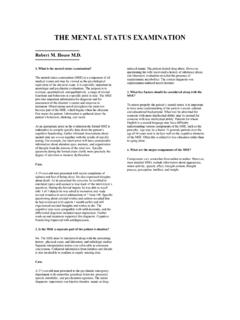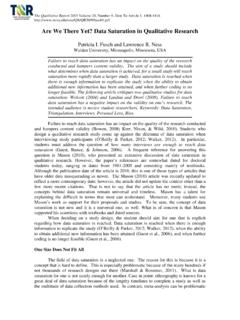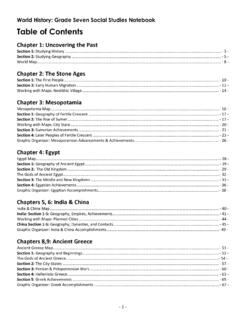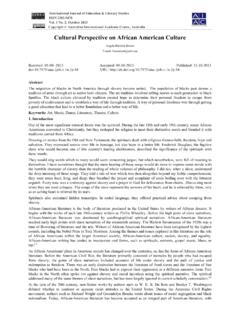Transcription of How did all the different ‘races’ arise (from Noah’s family)?
1 Chapter 18. How did all the different races' arise (from Noah's family )? What is a race'? How did different skin colours come about? What are the consequences of false ideas about the origin of races? Are black people the result of a curse on Ham? What about Stone Age' people? A. CCORDING to the Bible, all humans descended from Noah and his wife, his three sons and their wives, and before that from Adam and Eve (Genesis 1 11). But today we have many races', with what seem to be greatly differing features; the most obvious of these is skin colour. Many see this as a reason to doubt the Bible's record of history , believing that the various groups could have arisen only by evolving separately over tens of thousands of years.
2 The Bible tells us how the population that descended from Noah's family had one language and by living in one place were disobeying God's command to fill the earth (Genesis 9:1, 11:4). God confused their language, causing a break-up of the population into smaller groups that scattered over the Earth (Genesis 11:8 9). Modern genetics shows how, following such a break-up of a population, variations in skin colour, for example, can develop in only a few generations. There is good evidence ~ 223 ~. 224 ~ Chapter 18. that the various people groups we have today have not been separated for huge periods of What is a race'?
3 In one sense there is really only one race the human race. The Bible teaches us that God has made from one man all nations of mankind . (Acts 17:26). Scripture distinguishes people by tribal or national groupings, not by skin colour or physical features. Clearly, though, there are groups of people who have certain features ( skin colour). in common, which distinguish them from other groups. We prefer to call these people groups' rather than races', to avoid the unfortunate evolutionary connotations associated with the word race'. All people can interbreed and produce fertile offspring. This shows that the biological differences between the races' are small.
4 In fact, the DNA differences are almost trivial. The DNA of any two people in the world typically differs by just Of this, only 6% ( a minuscule ) can be linked to racial' categories; the rest is within race'. variation. Anthropologists often classify people into several main racial groups: Caucasoid (European or white'),3 Mongoloid (which includes the Chinese, Inuit or Eskimo, and Native Americans), Negroid (black Africans), and Australoid (Australian Aborigines). Virtually all evolutionists would now say that the various people groups did not have separate origins. That is, different people groups did not each evolve from different groups of animals.
5 So they would agree with the biblical creationist that all people groups have come from the same original population. Of course, they say that such groups as the Aborigines and the Chinese have had many tens of thousands of years of separation. Most people believe that there are such vast differences between groups that there had to be many years for these differences to develop. 1. Worldwide variations in mitochondrial DNA (the Mitochondrial Eve' story) were claimed to show that all people today trace back to a single mother (living in a small population). 70,000 to 800,000 years ago. Subsequent findings on the rate of mitochondrial DNA.
6 Mutations shortened this period drastically to put it within the biblical time-frame. See Loewe, L. and Scherer, S., Mitochondrial Eve: the plot thickens, Trends in Ecology and Evolution 12(11):422 423, 1997; Wieland, C., A shrinking date for Eve', Journal of Creation 12(1):1 3, 1998; 2. Gutin, , End of the rainbow, Discover, pp. 71 75, November 1994. 3. However, people inhabiting the Indian subcontinent are mainly Caucasian and their skin colour ranges from light brown to quite dark. Even within Europe, skin colour ranges from very pale to brown. How did all the different races' arise (from Noah's family )?
7 ~ 225. (3,000,000,000 base pairs). Within local ethnic group variation ( Cantonese). Human DNA. 85% Between ethnic & linguistic groups within a 'race'. ( Cantonese & Japanese). Between 'races'. 9% ( Asian & Caucasian). 6%. Variation between individuals The variation in DNA between human individuals shows that racial differences are tiny. One reason for this is a false perception that different racial characteristics such as skin colour are due to profoundly different genetic make-ups. This is an understandable but incorrect idea. For example, it is easy to think that since different groups of people have yellow' skin, red' skin, black skin, white' skin, and brown skin, there must be many different skin pigments.
8 different chemicals for colouring would mean different codes in the DNA for each people group, so it appears to be a problem. How could those differences develop within a short time? However, we all have the same colouring pigment in our skin, melanin. This is a dark-brown pigment that is produced in different amounts in special cells in our skin. If we had none (as do albino people, who inherit a mutation-caused defect, and cannot produce melanin), then we would have a very white' or pink skin colouring. If we produced a little melanin, we would be white'. If our skin produced a lot of melanin, we would be black'.
9 And in between, of course, are all shades of 4. Other substances can in minor ways affect skin shading, such as the coloured fibres of the protein elastin and the pigment carotene. However, once again we all share these same compounds, and the principles governing their inheritance are similar to those outlined here. Factors other than pigment in the skin may influence the shade perceived by the observer in subtle ways, such as the thickness of the overlying (clear) skin layers, and the density and positioning of the blood capillary networks. In fact, melanin', which is produced by cells in the body called melanocytes, consists of two pigments, which also account for hair colour.
10 Eumelanin is very dark brown, phaeomelanin is more reddish. People tan when sunlight stimulates eumelanin production. Redheads, who are often unable to develop a protective tan, have a high proportion of phaeomelanin. They have probably inherited a defective gene which makes their pigment cells unable to respond to normal signals that stimulate eumelanin production . See Cohen, P., Redheads come out of the shade, New Scientist 147(1997):18, 1995. 226 ~ Chapter 18. So the most important factor in determining skin colour is the amount of melanin produced. Generally, whatever feature we may look at, no people group has anything that is essentially different from that possessed by another.















